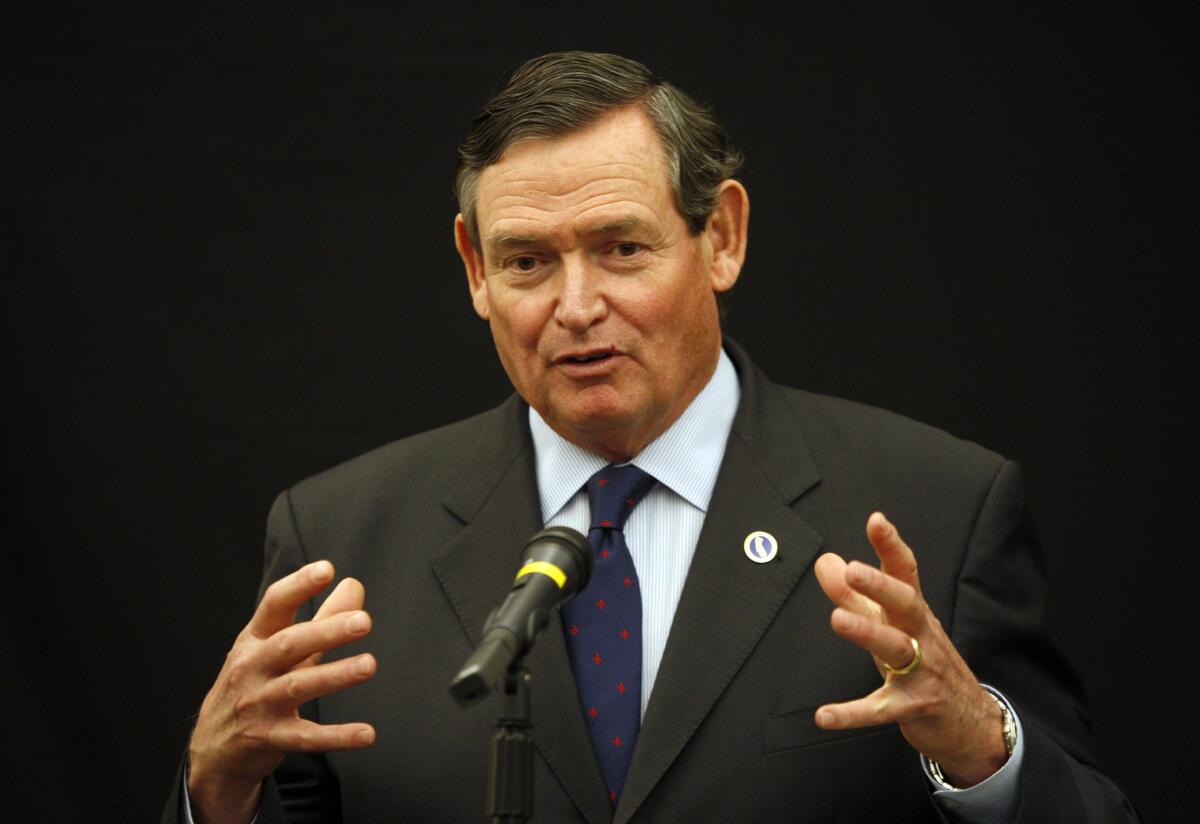State funding cuts during the recession still shortchanging Cal State students, officials say

- Share via
State budget cuts have left California State University with about 19% less in funding to spend per student compared with pre-recession years — compromising efforts to fully address student needs, university officials said.
The state spends about $7,858 per full-time student, compared with $9,686 in 2007-2008, adjusted for inflation, Assistant Vice Chancellor Ryan Storm told the Board of Trustees at a meeting Tuesday in Long Beach.
For the record:
8:52 a.m. Jan. 23, 2025A previous version of this article said the average four-year graduation rate for the Cal State system is about 17%. That number was 19% as of April, university officials said.
The state’s final budget agreement for fiscal year 2016-2017 gave Cal State about 60% of the additional funding that administrators wanted, which forced some priorities, such as student enrollment, to be downsized.
Cal State received an additional $154 million from the state general fund — raising total state support for the university system to $3.2 billion — plus one-time funding increases for maintenance needs and student success initiatives.
Trustees had requested an additional $110 million from the state for enrollment growth — enough to fund roughly 12,600 additional students. The final state budget plan allocated an additional $57.4 million, which will allow the system to accept about 6,100 new students.
This issue will continue to be a sticking point. Although enrollment has increased by about 20,000 since 2008, officials have not been able to make room for everyone who wants to attend one of Cal State’s 23 campuses.
Cal State is the largest university system in the nation and last fall had to turn away about 30,000 applicants who fulfilled all the admissions requirements, Chancellor Timothy P. White said.
The system, which serves about 460,000 students, is dependent on state general funds to cover about half its operating costs. The rest is covered by fees and tuition, which has been frozen for five years.
“That is the nexus of our dilemma,” White told the trustees. “In the absence of resources, and you look at the difficult decisions we had to make to live within our means again this year, you see that we end up disinvesting in those support services that enable the very students that we ourselves are under the gun to get their degrees sooner rather than later.”
Cal State has also had to compromise on addressing a backlog of buildings that are in need of repair or replacement — maintenance work totaling about $2.6 billion and growing by $150 million each year, officials said. Trustees requested an additional $25 million each year in the state budget but instead received a one-time boost of $35 million earmarked for this year’s most urgent infrastructure needs.
Cal State had also sought an additional $50 million to improve graduation rates, such as hiring more tenure-track faculty and providing more hands-on academic advisers. In its final budget plan, the state allocated $10.2 million as well as a one-time appropriation of roughly $15 million toward improving degree completion. An additional one-time boost of $35 million is expected in the fall once university officials have updated goals and plans to improve graduation rates.
California Gov. Jerry Brown has been sharply critical of Cal State’s performance: Across the country, the average four-year graduation rate for public universities is about 34%. For the Cal State system, the average is about 19%.
White wants to raise that rate to 24% by 2025. Trustees are expecting a report in September on how the university plans to reach that goal.
Following the budget discussion Tuesday, the board unanimously agreed to grant White, six vice chancellors, and 18 campus presidents a 2% increase in compensation.
The 2% raise will cost the system a total of $160,185, White said. Five new presidents, whose salaries were set when they took office July 1, were not included in this increase.
Executive compensation has been a thorny issue in the past: The system took heat in 2011 when trustees approved a $100,000 increase in compensation for the incoming San Diego State president as it also increased annual student tuition by 12%. The next year, Cal State adopted a policy that froze compensation paid with state funds while allowing a 10% increase paid with private donations. In November 2015, in a move to quell criticism and controversy, the trustees voted to eliminate the use of private funds to supplement salaries.
From 2010 to 2014, executives received no salary raises, officials said. In the 2014-2015 budget year, a 3% increase was approved, followed by a 2% increase in 2015-2016.
Officials had long argued that restricting compensation puts the system at a disadvantage when trying to attract the most qualified candidates.
“Recruiting and retaining high quality leadership, faculty and staff for the CSU is important for the short and long-term health of our enterprise,” White told the board, “and it is critical to the overall success of our students and our system.”
White’s salary, after the 2% increase, will total $439,361. Campus president salaries now range from $267,903 at the Maritime Academy to $428,645 at San Diego State.
Follow @RosannaXia on Twitter for more higher education news.
More to Read
Sign up for Essential California
The most important California stories and recommendations in your inbox every morning.
You may occasionally receive promotional content from the Los Angeles Times.











